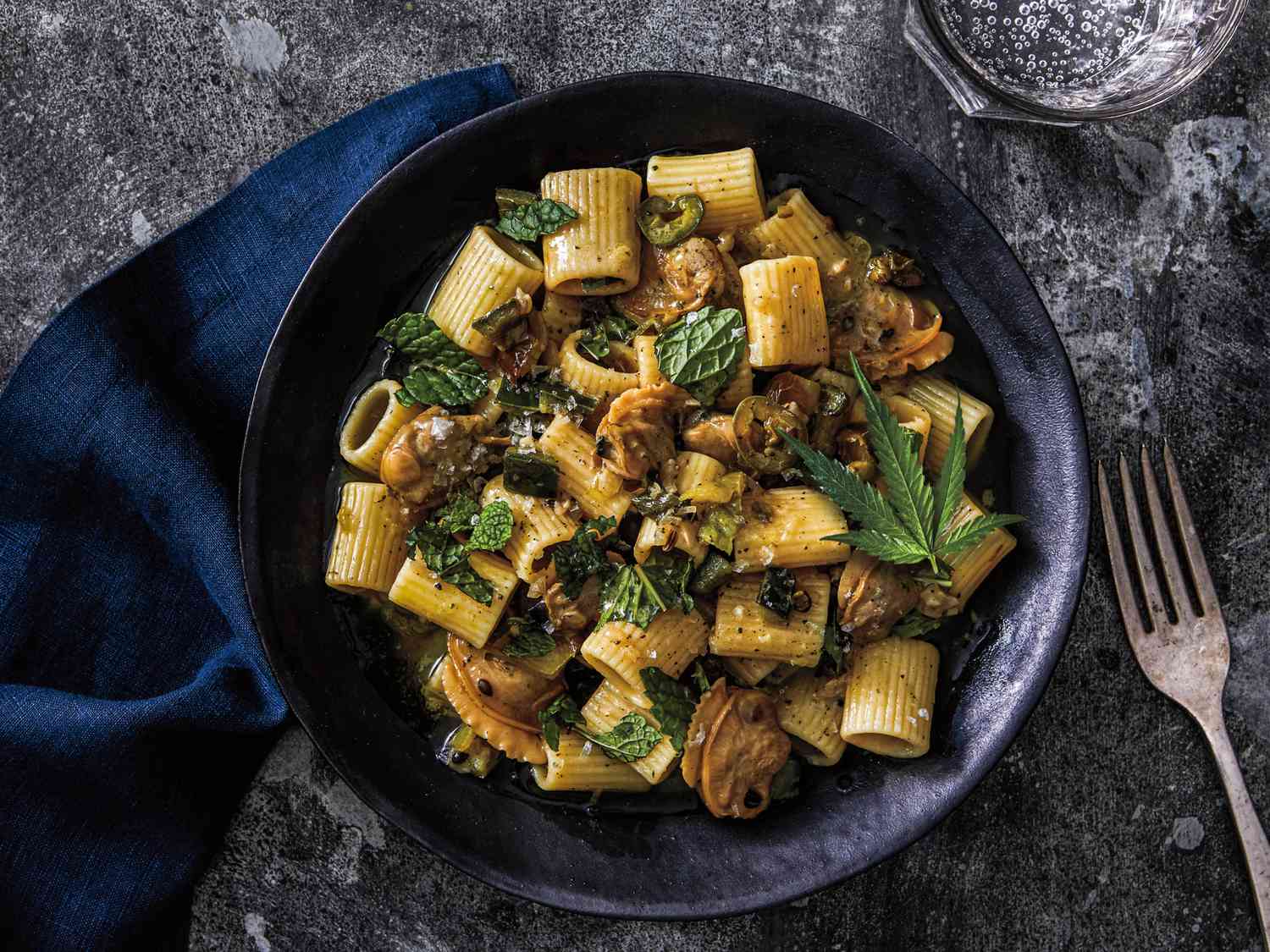Cooking With CBD: A How-To Guide

CBD is a widely known and loved hemp-derived ingredient that people use to holistically support their overall wellness. Many people regard CBD the same way they regard ingredients like kombucha, wheatgrass, or smoothie green powder. It’s something they add to their lifestyle that promotes their overall wellbeing.
Food and wellness are inextricably connected. You have to ingest your CBD in order for it to reach your body’s endocannabinoid system and provide its full host of wellness benefits. Why not add it to your wellness ritual the same way you incorporate a mug of matcha or your homemade juice?
Before you start mixing CBD oil into your ancient grain protein waffle batter, take another look at your recipe book. CBD is a great addition to many foods, but it can be a finicky ingredient to cook with.
Here’s what you need to know about whipping up a batch of CBD treats.
Why Make CBD Snacks?
CBD tinctures are ready to use directly out of the bottle. There’s absolutely no need to cook with them or mix them into anything else. If you’re looking to keep things simple, you can take your daily dose exactly the way it came. All that matters is that you take it regularly.
But, even as simple as this sounds, there are still a handful of reasons you may want CBD beyond the tincture.
For Ease of Use
Some people find that incorporating CBD into foods, drinks, or snacks makes it easier for them to use their CBD regularly.
If you like to meal prep your breakfast for the week, or if you’re already in the habit of making coffee every morning, tethering your CBD into your ritual makes consistent use easier.
If you already use a lot of supplements or special ingredients in your post-workout smoothie, it only makes sense to toss a few drops of CBD into the blender. You can consume your greens, your CBD, your antioxidant drops, and your protein powder all at the same time.
To Disguise the Taste
CBD oil has a distinctly nutty, earthy flavor that may be described as similar to dirt. Some people enjoy the natural flavor of CBD, or at the very least, they don’t find the flavor unpleasant enough to dissuade them from using it. Others really dislike the natural flavor of hemp and would prefer to mask it with something else.
Sweet or nutty flavors typically do a good job of disguising the taste of CBD oil, especially if the CBD oil is heavily diluted. CBD works well in foods and drinks that have other ingredients with stronger flavors — think peanut butter, chocolate, or even turmeric.
The earthiness of the CBD is balanced out by the sweet and earthy notes of other foods that people generally find more agreeable.
To Serve CBD to a Crowd
Alcoholic beverages aren’t always the most appropriate choice for get-togethers, especially if the people attending don’t drink or prefer not to get drunk. Traditional cannabis isn’t recreationally legal in most states.
CBD, on the other hand, is legal to obtain and use in most places.
CBD edibles have the same general vibe as cannabis edibles, but with a few important distinctions. After enjoying a CBD-infused snack, people might feel calm and relaxed, but they won’t feel intoxicated or impaired in any way.
Guests can enjoy several CBD edibles and still safely drive themselves home at the end of the night (then continue to enjoy the wellness benefits the day after, too).
Can You Cook with CBD?
Cooking with CBD can get a little tricky.
Full-spectrum CBD oil gets its benefits from the full wealth of cannabinoids and terpenes it contains. Light and heat are natural enemies of cannabinoids and terpenes, causing them to degrade or convert to less potent cannabinoids that may not be as beneficial to the body.
When cannabinoids are initially exposed to light and heat, they begin a process called decarboxylation. This process activates the cannabinoids. If the process goes on for too long, it essentially burns the benefits off.
CBD can only withstand temperatures of up to 350 degrees Fahrenheit for short periods of time before it’s essentially rendered useless. Other cannabinoids, like the small amounts of naturally occurring THC in full spectrum hemp extract, will degrade at temperatures below 300 degrees.
Any exposure to heat from an oven or a stovetop runs the risk of diminishing the benefits of your CBD.
Why cook with CBD if it’s going to defeat the entire purpose of using it in the first place?
It’s better to think of CBD as a recipe enhancer, rather than a cooking ingredient. Anything that would be heated to a temperature that’s too hot to eat or drink can damage your CBD. By saving your CBD for cold, room temperature, or just slightly warm foods, you’re eliminating the risk of destroying those beneficial plant parts.
Can you make CBD-infused brownies as a friendlier, more healthful version of THC brownies? Yes, you technically can. But should you? Probably not. The CBD is best reserved for the cream cheese icing or nut butter spread you’ll ultimately put on top of the finished brownies. Again, you need to treat your CBD as more of a finisher than a main ingredient if you want to retain its wellness benefits.
What Kind of CBD Should I Use for Cooking?
There are several kinds of CBD, and each has its own advantages and disadvantages when it comes to cooking.
CBD Oil
CBD oil is the kind of CBD that people are most familiar with. CBD oil is cannabinoid extract from the hemp plant that has been diluted to an appropriate strength and blended with a food-safe carrier oil like olive oil, hemp seed oil, or MCT oil.
CBD oil is the most convenient way to cook a single serving of CBD-infused food as long as that food contains at least a little bit of naturally occurring fat.
Oil and water don’t mix. If you were to put a few drops of CBD oil into black cold brew coffee, the two would never incorporate. The CBD would sit on the top of your drink in shiny little splotches.
Conversely, CBD mixes well with fat. If you wanted to make CBD cold brew, you’d have much better luck mixing CBD with cream or coconut milk, and then pouring the milk into your coffee. The CBD oil will disperse better throughout your coffee creamer, and the coffee itself will dilute the mixture.
CBD Infused Hemp Seed Oil
There’s also hemp seed oil infused with CBD.
Regular hemp seed oil doesn’t contain any CBD at all. Infused hemp seed oil, however, introduces the CBD-rich extract from the plant material to the fatty acid-rich oil extracted from hemp seeds.
This type of CBD is intended for both food and skincare preparations — the healthy fats in hemp seed oil provide nutritional value as well as skin-soothing benefits, all in conjunction with the benefits of CBD.
All that said, heating hemp seed oil can damage its nutritional profile. It’s not intended for frying or sauteing.
CBD infused hemp seed oil is best for foods that will be drizzled with oil after they’ve been cooked, or for foods that don’t need to be cooked at all. You can easily add some garlic and herbs to hemp seed oil and serve it with toasted bread for a simple, savory appetizer.
CBD Isolate Crystals
Last (and most certainly not least) are CBD crystals. evo hemp CBD Crystals look like powdered sugar. They’re almost exclusively pure CBD, with just a little bit of naturally occurring hemp plant fat to keep the texture manageable. Isolate crystals don’t contain any oil at all.
Because there’s no oil to contend with, CBD isolate crystals will dissolve in just about anything. You can add isolate crystals to black coffee, tea, or fruit juice. You can even sprinkle them on a slice of watermelon.
Easy CBD-Infused Breakfasts
CBD oil can easily be incorporated into dairy products or coconut-based dairy alternatives. You can use them as creamer for your coffee or tea.
You can make CBD yogurt parfaits, overnight oats, smoothies, or acai bowls.
If you like to keep your breakfast simple, mix some CBD oil with nut butter or seed butter and enjoy it on a piece of multigrain toast with some fruit. You can mix yourself up a whole jar of CBD-infused peanut butter to take the effort off your morning CBD fix.
Simple CBD for Lunch or Dinner
CBD-infused hemp seed oil often plays perfectly with savory dishes.
You can mix CBD-infused hemp seed oil with vinegar and herbs to make your own vinaigrettes. Use them as salad dressings, put them on sandwiches, or toss them over pasta with vegetables for a simple dinner.
If you’re proficient in the kitchen, you can use CBD-infused hemp seed oil in place of olive oil to make cold spreads and sauces like fresh pesto, bruschetta, dips, or tapenades.
You can blend CBD hemp seed oil with cooked chickpeas and herbs to make your own hummus.
It’s simple — any time you would use olive oil in a cold recipe, just make the substitution.
Incorporating CBD Into Sweets
Although you can technically bake with CBD, it isn’t worth potentially damaging and sacrificing valuable cannabinoids. It’s better to mix CBD into frosting or whipped cream (either homemade or premade), nut or seed butter spreads, fruit jams, honey, or even custard. You can add these cold ingredients to the finished product and use your CBD as a topper.
This is also a great approach if you’ll be serving CBD to a family or at a gathering where CBD may not be suitable for everyone in attendance. Children can have cupcakes with traditional frosting while adults can enjoy CBD-infused frosting. You can also offer CBD-infused toppings separately, allowing people to select how much CBD they’d like to consume.
evo hemp Makes Cooking with Hemp Easy
Our full range of CBD and hemp products can be enjoyed however you’d like to enjoy them — use it the way it comes or incorporate it into your favorite foods or drinks.
If you’re not much of a cook, we always have CBD gummies for a stress-free CBD snack that’s always ready to go — we promise you can have this kind of dessert for breakfast!
Sources:
Mechanisms of Action and Pharmacokinetics of Cannabis | Permanente Journal
Hempseed as a nutritional resource: An overview - Euphytica | Springer Link



